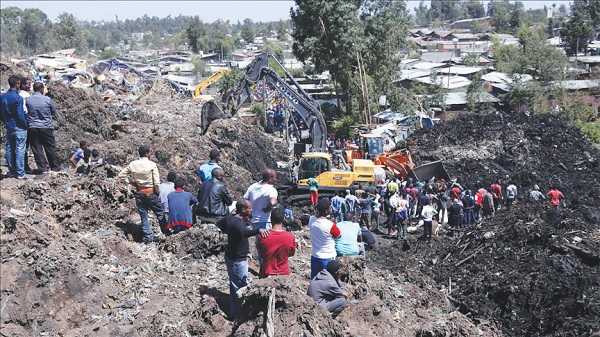
Ethiopia has a diverse range of natural terrain. This terrain is characterized by hilly areas and steep slopes that are extremely prone to landslides for a variety of causes. Increasing unpredictability in rainfall is one of the noteworthy aspects. Ethiopia is experiencing increasingly severe rainfall patterns as a result of climate change. A lot of rain can saturate the soil, which increases the risk of landslides, particularly in steep and mountainous places.
According to various studies, landslides can occur due to a variety of reasons, including droughts and soil deterioration. Even, dry periods can be a cause of landslides. Prolonged droughts can cause soil to dry up, resulting in cracking and diminished particle cohesiveness. When strong rains follow a drought, the unexpected rush of water can cause landslides. Furthermore, deforestation and unsustainable farming practices worsen soil degradation by decreasing the land’s ability to absorb water and increasing runoff.
The risk of landslides is increased by human activities such as rapid urbanization, especially in hilly areas, because these activities cause slopes to become unstable. Landslides are also caused by agricultural growth because farmers frequently clear land for farming on steep slopes without taking the necessary precautions to conserve the soil, which makes the area more susceptible to landslides.
Climate change, along with other variables, offers considerable concerns for Ethiopia, notably in terms of landslides. Landslides may destroy houses, infrastructure, and agricultural land, causing relocation and loss of livelihoods. It also affects agricultural activity, resulting in food insecurity in a nation where agriculture is the major source of subsistence. The Gofa landslide serves as an excellent illustration. A landslide occurred in the hilly terrain of Geza Gofa Woreda, Gofa Zone, South Ethiopia Region, due to heavy rainfall on July 21 and 22, 2024. According to the World Health Organization (WHO) July 26, 2024 No 1 Situation Report titled “Ethiopia: Landslide in Gofa Zone, South Ethiopia Region,” stated that Southern Ethiopia is a flood-prone region that has previously seen several emergencies including malaria, measles, and cholera. The warm atmosphere caused by climate change has resulted in heavy rains, increasing the likelihood of such catastrophes. These problems emphasize the urgency of the issue. Even as of July 25, at least 257 people had been killed, and more than 15,000 had been affected.
The Chief Administrator of the Southern Ethiopia Region Tilahun Kebede said that the area has been devastated by landslides, mainly due to climate change and human activity. Landslides occurred in Gofa, Gozdi Kebele, Southern Ethiopia area, killing over 226 persons, and over 6,000 vulnerable residents have been designated for relocation. The accident resulted in a tragic circumstance for the children who lost their families. Works are being carried out to give short-term assistance as well as lasting rehabilitation.
Here, the most significant concerns are how a landslide danger occurs and what steps should be taken to lessen the risk. According to Addis Ababa University Soil Science Professor Mohamed Hasan, the recent landslide in the Gofa zone, Geze Gofa Woreda, is one of the calamities that resulted in widespread loss of life in Ethiopia.
“As far as I know, this is not the first time such an accident has occurred in the Gofa zone. Although the latest one did significant damage, the threat was previously present. There is still concern that several regions in the Gofa zone surrounding Abaya Lake may experience recurrent soil erosion. High rainfall is one factor contributing to the problem’s worsening, but as the soil’s capacity to connect itself to one another diminishes and becomes more porous and loose, landslides are more likely to occur.”
“If soil and water basin protection were effectively developed, the problem may be reduced not only in the Gofa zone but across the country. Therefore, the government should enhance watershed management efforts to lower the risk of landslides.”
He also pointed out that “in science, soil and other portions of the planet are inextricably linked. A soil particle can also attach to another substance, as well as to the surface or subsoil. However, rain causes the connected soil to loosen and soften. As a result, the glue holding them together melts. That’s when slippage occurs”.
“When the amount of rain and moisture in the soil is high, especially in sloping areas, in hilly areas, when the loose soil goes down due to gravity, landslides occur. A similar problem occurred in the Gofa zone. That’s why it came down and hurt a lot of people,” he explained.
Planting trees can help to restore balance to nature. The earth binds as plants grow. The portion of the plant that stays in the soil is balanced by the quantity of water in the area where the plants are located, so it may not cause landslides or other issues until it is touched by humans for different reasons.
So, watershed management tasks are critical for reversing the source of landslides. Entoto might serve as an excellent example in this regard. However, the area is sloppy and prone to soil erosion, yet there are so many trees that it has a high potential to collapse. Therefore, this environmental protection work should also be implemented in various sloping areas and the soil and water conservation work should be monitored to prevent illegal land use for agriculture, he said.
Additionally, he recommended that since steep slopes are available in Ethiopia, it is essential to strengthen efforts to conserve water and soil by planting and caring for trees. This way, the soil’s binding capacity will increase and reduce the likelihood of landslides.
Addis Ababa University Geo Physics, Space Science Astronomy Institute Head Professor Atalay Ayele said that landslides of the recent Gofa type, which occur frequently in the winter season in southern Ethiopia, are related to the lack of soil and water conservation work.
Besides, landslides occur when non-cultivable mountain areas are utilized for agricultural purposes, forests are depleted, and groundwater aquifers are drained. When soil and water conservation work is not done properly, the likelihood of water seeping into the earth after rains reduces, causing underground natural water barrels to become empty. Therefore, it is necessary to carry out intensive soil and water protection work in the threatened areas to control the landslide hazards that may occur in different parts of the country.
He emphasized that watershed management works are the solution to the issues caused by humans’ unfair effects on the environment, particularly land degradation due to deforestation. To prevent similar disasters, strong soil protection work should be carried out via watershed management activities.
Indeed, it’s worth noting that the Gofa landslide, which claimed several lives, was a highly challenging and tragic event. Ethiopia has serious issues as a result of the interaction between climate change and landslide occurrences, which need coordinated methods for risk reduction and adaptation. Mitigating the effects of landslides caused by climate change nationwide requires addressing the root causes of vulnerability, such as deforestation and unsustainable land use, as well as building community resilience through education. In particular, strengthening watershed management development is critical for sustaining water supply, and protecting ecosystems. By combining scientific research with community participation and sustainable practices, stakeholders may collaborate to conserve landslides for current and future generations.
BY EPHREM ANDARGACHEW
THE ETHIOPIAN HERALD WEDNESDAY 31 JULY 2024





